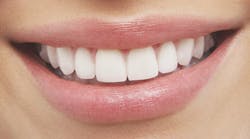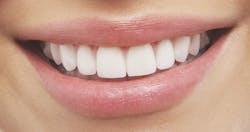Protecting our patients' smiles before, during, and after whitening
BY Patti DiGangi, RDH, BS
A tooth whitening case is currently before the United States Supreme Court. This case is not a lawsuit about a person's teeth being too white or not white enough. This case is not about how whitening procedures are performed. Instead, it's about who can offer whitening services. The outcome of North Carolina State Board of Dental Examiners v. Federal Trade Commission will determine who has the right to provide whitening services (see Table 1 for more information about the case).
Our patients want bright, white, natural-looking smiles. Dental professionals can easily differentiate professional care from whitening provided by commercial, unlicensed whitening businesses. Professionals know the benefits and the risks of whitening and have the know-how to help patients prevent and treat sensitivity.
50 shades of white
Playing off of the popularity of the book and soon-to-be movie, 50 Shades of Grey, the American Academy of Cosmetic Dentistry (AACD) created a paper called the 50 Shades of White, based on the results of a 2014 whitening survey (shown in Table 2). The conclusion, according to AACD President Dr. James Hastings, is that: "Teeth whitening is still the most popular cosmetic dentistry procedure ... People want to look like they were born with their smile, not like they have purchased it."
----------------------------------------------------------
Other articles by DiGangi
- Digital natives and EHR: Three simple steps propel you to the multiple uses of electronic health records, regardless of whether you're a 'native' or an 'immigrant'
- Health span vs. life span for baby boomers: Marketing has painted a target on these consumers, but how far should dentistry go?
----------------------------------------------------------
A huge variety of products and procedures are available to help patients gain the natural look. Any invasive procedure has pros and cons, however, and the most common effect of whitening is producing or exacerbating sensitivity. Prevention is always the best method for creating excellent outcomes.
Chemical reactions
The active ingredient in whitening products is either carbamide peroxide or hydrogen peroxide, both of which dehydrate the enamel structure and create a chemical reaction by destroying the chromospheres in the pigments that stain teeth. Chemical destruction and dehydration are the irritating effects of peroxides, although patients' reactions to these processes vary from no noticeable symptoms to extreme sensitivity.
Whether the patient feels an effect should not be the basis for protecting the tooth structure and preventing pain. The symptoms are not the cause of the health problem, as shown in Figure 1.
Instead, Figure 2 accurately depicts the cause-and-effect relationship between symptoms, diseases, and dysfunctions. Symptoms are not the first indication of a health problem; they are the last.
Figure 1: Accurate description
Table 1 For more information about North Carolina State Board of Dental Examiners v. Federal Trade Commission • ADA statement on the Supreme Court/North Carolina Dental Board case." American Dental Association. http://www.ada.org/en/press-room/news-releases/2014-archive/october/ada-statement-on-the-supreme-court-case • Liptak A. "Regulatory case in North Carolina appears to trouble Supreme Court." New York Times. http://www.nytimes.com/2014/10/15/business/north-carolina-dental-board-case-troubles-supreme-court.html?_r=2 • Otto M. "Supreme Court hears case over teeth whitening, professional board's power." Association of Health Care Journalists. http://healthjournalism.org/blog/2014/10/supreme-court-hears-case-over-teeth-whitening-professional-boards-power/ • Totenberg N. "Supreme Court hears arguments in teeth whitening case." NPR. http://www.npr.org/2014/10/14/356177201/supreme-court-hears-arguments-in-teeth-whitening-case Table 2 Results from the American Academy of Cosmetic Dentistry 2014 Whitening Survey • 99.7% of adults surveyed believe a smile is an important social asset. • 96% believe an attractive smile makes a person more appealing to members of the opposite sex. • 74% feel an unattractive smile can hurt a person's chance for career success. • When respondents were asked, "What would you like to improve most about your smile?" the most common response was: "Whiter and brighter teeth." |
This simple differentiation makes all the difference. A lack of symptoms does not equate to good health. This is why waiting for symptoms during or following a whitening procedure is not the best course of action. Surfaces should be evaluated and protected prior to, during, and after each whitening treatment.
Products to evaluate
Evaluating the tooth structure prior to whitening procedures is a more effective mode of problem prevention, and it establishes care as professional. As a dental hygiene clinician, I have seen practice after practice watch and wait for breakdown to occur - not because of bad intent but because the gold-standard detection devices could not detect problems until significant damage was done to enamel. Risk assessment with, for example, the Spectra by Air Techniques is an objective means of monitoring previous "watch" areas to help clinicians know whether preventive care or remineralization therapy should be increased, decreased, or continued as is. Remineralization therapy is needed when the whitening process causes chemical dehydration that destroys tooth structure.
Most whitening gels contain potassium nitrate and sodium fluoride to seal dentinal tubules and thereby reduce sensitivity. Many fluoride varnishes are on the market, as well.
Profluorid L by VOCO America is one of the most ideal options for whitening patients because it provides the powerful protection of a liquid varnish before, during, and after the whitening procedure. Profluorid L is a thin, synthetic resin containing 5% sodium fluoride, 5% calcium deposits, and eugenol. It aids in desensitizing and doesn't interfere with the whitening process. The delivery system is different from other varnish products in that its liquid consistency makes it easy to apply a thin, clear layer of esthetically pleasing protection. Profluorid L is also free of common allergens, such as gluten, glutaraldehydes, methacrylates, or colophony (tree sap).
In addition to applications for whitening procedures, Profluorid L can also be considered for:
• Protection before and after the placement of orthodontic brackets.
• Conservative dentistry, including polishing or post-periodontal care.
• Sensitivity during prosthetic procedures in both the provisional and final stages.
Hand in glove with professional preventive treatment, the dental practice can provide home products to further protect the oral structures. A product containing fluoride is often the single option offered to patients with sensitivity, yet fluoride alone provides only part of what is needed. In addition to fluoride, home products should also include hydroxyapatite (nHAP) and xylitol. These ingredients can be found separately in a variety products, although Remin Pro, another unique product from VOCO America, contains all three ingredients.
Let's look closely at this combination of ingredients. We are already fully acquainted with fluoride. The second ingredient, nano-hydroxyapatite (nHAP) is utilized for its bioactivity, biocompatibility, and similarity to the mineral composition of teeth. The nHAP is easily integrated into the dentinal tubules, enhancing their occlusion. It seals the tubules and prevents exposure of the nerves to external stimuli, thereby reducing dentinal hypersensitivity. The third ingredient, xylitol, is a five-carbon sugar alcohol that is often used as a natural sweetener and that does not support the growth of cariogenic biofilm due to the bacteria's inability to metabolize it. The effects of xylitol promote tooth remineralization. Xylitol is also hygroscopic, which means that it attracts and holds water molecules from the surrounding environment - exactly what dehydrated surfaces need. Together, these three ingredients create a "perfect storm" product for treating damaged surfaces.
The Supreme Court will eventually decide the case before them. Until then, patients have choices for whitening, and professionals have choices for products. As professionals, we have the opportunity to show how and why what we offer is superior. The choices made will differentiate the outcomes. RDH
Patti DiGangi, RDH, BS, continues to take an active, future-oriented leadership role in a variety of professional organizations. She is a certified Health Information Technology trainer and author of the DentalCodeology series of easy-to-read, bite-size books on coding. Patti is an ADA Evidence-Based Champion and holds a publishing license with the American Dental Association for Current Dental Terminology. She is the 2013 Sonicare/RDH Mentor of Distinction winner and 2014 Sunstar/RDH Award of Distinction. She can be reached at [email protected].









